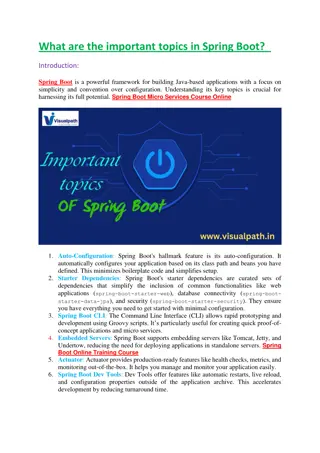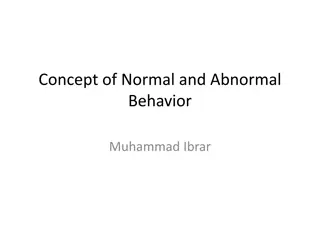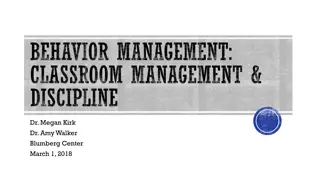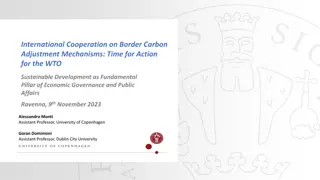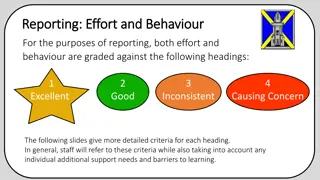
Effective Dog Training Methods: Insights from Behavior Adjustment Therapy Study
A study by Hiby, Rooney & Bradshaw (2004) surveyed pet owners in England to explore the effectiveness of different dog training methods. The research compared reward-based and punishment-based training approaches, revealing that reward methods correlated with higher obedience scores and fewer behavior issues. Punishment, on the other hand, was linked to more problematic behaviors, excitability, and separation-related problems in dogs. The study emphasized the importance of positive reinforcement techniques in behavior adjustment therapy.
Download Presentation

Please find below an Image/Link to download the presentation.
The content on the website is provided AS IS for your information and personal use only. It may not be sold, licensed, or shared on other websites without obtaining consent from the author. If you encounter any issues during the download, it is possible that the publisher has removed the file from their server.
You are allowed to download the files provided on this website for personal or commercial use, subject to the condition that they are used lawfully. All files are the property of their respective owners.
The content on the website is provided AS IS for your information and personal use only. It may not be sold, licensed, or shared on other websites without obtaining consent from the author.
E N D
Presentation Transcript
Behavior Adjustment Therapy U S I N G C L A S S I C A L C O N D I T I O N I N G A N D S Y S T E M A T I C D E S E N S I T I Z A T I O N T O H E L P Y O U R D O G F O C U S A N D R E D U C E I T S F E A R !
Surveyed pet owners regarding the training methods they employed with their dog In this survey, examined effectiveness of the different methods Hiby, Rooney & Bradshaw, 2004 Why? Because previous studies find mixed results: Some authors found NO relation between training and behavior issues: they suggested it was mostly due to genetic/breed differences Other authors (well, even some of the same) found that positive reward methods were more effective. Hiby, et al., assumed it was the method of the survey that was defective
Three different sites around England High concentration of dog walkers Also surveyed some local vet clinics Dog must be over 1 year of age Questionnaire examined Hiby, et al. s survey Training methods and obedience Obedience: Rate on scale of 1 to 5 (most obedient) Training: Reward only, punishment only or combination Problematic behaviors: Given list of 16 problematic behaviors; asked to note which that their dog showed in the past, currently or never Demographics of the owners and the dogs
Demographic results: Most respondents were female (70% to 30%) Did find some differences across the 3 sites: more females and more owned dogs Nice mix of owned breeds Hiby, et al. s survey Problematic Behaviors: Top 3: Barking at people, aggression at people, barking at dogs After that: Aggressive interactions with dogs (nipping, growling) Fear Overexcitement Separation Inappropriate Mounting/repetitive behavior/pica
Training methods used Used punishment for stealing, chewing, Used rewards for sit or come. 20% used reward only 10% punishment only 60% used combination No correlation between punishment and obedience rating BUT highest obedience scores found for those using reward Data showed that play, praise and redirection worked well Punishment DID correlate with the number of problem behaviors (but reward did not) Owners relying on punishment had dogs with more behavior problems, higher excitement levels, and highest separation related problems
Classical or Operant Conditioning? Classical or Operant Conditioning? Both are types of learning (as defined by learning theorists) Both involve cues and responses to those cues Only predicts the event Classical conditioning: Ability of a cue to PREDICT some event Animal does NOT have to make a response; response is usually preparatory Cue tells you that the IF/Then contingency is in effect Operant conditioning: Cue predicts that IF you make a response, then a certain consequence will occur Animal MUST make response to get predicted consequence
Basic Set up of Classical Conditioning Basic Set up of Classical Conditioning Based on Predictability: CS US UR 4 parts: CS: Conditioned stimulus CR US: Unconditioned stimulus CR: Conditioned response UR: Unconditioned response
Applications of Classical Applications of Classical Conditioning Conditioning Learning Emotional Reactions Learn that certain stimuli predict certain events Learn to anticipate upcoming emotion Show emotion to predictive stimulus E.g., learn to be afraid of tornado watches, not just the tornado: CStornado watch UStornado URfear CRfear Demonstrates that most fears and many emotions may be learned You are afraid of spiders because your mother startled you when you picked it up! We ominous music with upcoming startle!
Little Albert Study Little Albert Study Watson and Raynor CSwhite rat US loud noise URfear CRfear Then showed generalization to other objects with white fear (NOT Santa Claus!) Conditioned young child- Albert (about 18 mos old) Were going to impose extinction, but Albert moved away!
How undo a learned fear? How undo a learned fear? Systematic desensitization Teach client to relax first Develop a hierarchy of fear- related stimuli and situations The substitute predictive CS and CR as introduce to fear hierarchy CSwhite rat US relaxing cue UR relax CRrelax
Considered to be a fairly new behavior therapy approach developed by Grisha Stewart, MA, CPDT-KA She started to publicly practice BAT as early as 2009 She argues it has a short history We know it is really a form of systematic desensitization Joseph Wolpe described this in 1958 Behavior Behavior Adjustment Adjustment Training (B.A.T.) Training (B.A.T.) Regardless of what we call it, this technique is widely used around the world and appears highly effective.
The client is exposed to the anxiety-producing stimulus at a low level and once no anxiety is present a stronger version of the anxiety-producing stimulus is given. This continues until the client no longer feels any anxiety towards the actual stimulus. There are three main steps 1.Teach the client relaxation techniques Wolpe s rationale: you cannot be both relaxed and anxious at the same time. 2.Client and the therapist create a hierarchy of anxieties. The therapist has the client make a list of all the things that produce anxiety in all its different forms. With the therapist, the client makes a hierarchy: Starts with what produces the lowest level of anxiety Ends with what produces most anxiety. 3.Client is fully relaxed while imaging the anxiety producing stimulus. Depending on their reaction, the stimulus will then be changed to a stronger or weaker one. Wolpe s Wolpe s Systematic Systematic desensitization desensitization Issue with this: Dogs can t talk and tell us what is going on in their head.
Systematic desensitization Involves: Functional communication training Constructional Aggression Treatment Clicker (marker) training BUT: relies heavily on reward training principles: Negative reinforcement Multiple rewarding systems What Exactly is What Exactly is BAT BAT Environmental factors Must understand several aspects of dog s life: Dog s personality How the dog uses canine signals and body language. Must create many scenarios and engage in many, many repetitions for this to work!
Find the baseline space The distance from the trigger where your dog displays a mild reaction to the stimulus Point at which you get a small reaction, not the big reaction CRITICAL that you keep the dog under threshold. Wait for your dog to offer an alternative behavior to the fear/aggressive response How do you start? Looking around Sniffing the ground Looking at YOU! At that moment you mark that new behavior (clicker training principle) and reward your dog. Use a functional reward.
Must determine Must determine stress level stress level And keep dog under aggression threshold
Type of rewards (given contingently on that alternative response) that are directly related to a certain situation, scenario or environment. NOT always a food reward: Escape or Aggression is rewarding! How can we work with this? Functional Functional Rewards Rewards Examples: An aggressive behavior towards people results in people moving away: Reinforcement is reduction of fear because the people moved away Dog is pulling you on a leash: Reinforcement is getting to go in the direction/speed that the DOG wants to go. As Grisham states: Most attention seeking behaviors exist because you do something that your dog requires at that moment which serves as a functional reward
First: locate the triggers and locate what the functional reward is for that particular behavior. Most aggression occurs because it results in the person/animal LEAVING or moving away from the dog Seeing the trigger leaving is the functional reward that comes after the aggressive behavior. How can WE How can WE use functional use functional rewards with rewards with BAT BAT? ? Alternatively: Aggression may occur to GET something: A toy, a person, food, etc. This is resource guarding The functional reward is getting the desired object/space Why are aggression behaviors so difficult to reduce or eliminate? These behaviors are highly rewarding for the dog S/he quickly learns that by displaying this type of behavior he can control the environment in the way s/he wants.
Dog displays aggressive responses people/others move away Dog is reinforced because the fearful stimulus goes away With With BAT to replace the to replace the aggressive aggressive behavior with behavior with an appropriate an appropriate behavior! behavior! BAT, want , want Replace that behavior: Dog displays alternative response people/others move away Dog is reinforced because the fearful stimulus goes away Gradually, we also work on making the fearful stimulus less fearful
Environmental cue (the trigger in the environment to which the dog reacts; e.g., another dog) Behavior (the response that the dog offers in that situation; e.g., an aggressive response) Functional reward ( trigger leaves or you end up removing your dog from the situation: Both reinforcing to the dog) BAT BATfollows a follows a simple simple sequence sequence (it just looks (it just looks complicated) complicated) Work towards a new scenario Expose the trigger at a distance where the dog doesn t react (low arousal level) Wait for your dog to look at the trigger (stimulus) and to offer an alternative behavior (looking at you, sniffing, etc.) Mark that behavior AND turn around and leave (functional reward). You can also offer additional treats to your dog after that, as well (second reward)
Use the BAT flow chart
Negative reinforcement: Response increases when unwanted stimulus is removed So: In our example: Notice we Notice we actually are actually are using NEGATIVE using NEGATIVE reinforcement: reinforcement: Negative reinforcement (fear response: look at you and you move dog away) Positive reinforcement (praised for look behavior and allowed to move away contingent on look behavior) Positive reinforcement (treat) NE NE- -PO PO- -PO PO Bart Bellon refers to this as NE-PO-PO (short for negative-positive-positive reinforcement). Stress that the dog is exposed to when facing another dog at a low arousal level (this is the negative reinforcement) is relieved/shut off by dog offering a more appropriate behavior rather than the aggressive response
Really just relearning Really just relearning Dog learns that offering new alternative behavior results in same environmental control as aggression did. Relatively fast behavior rehabilitation process Dog learns an alternative and likely easier way to control its environment BUT: now you must teach the dog to generalize this response in several ways. With increased intensity of the fearful stimulus (person/dog gets closer) In MANY situations, not just the training situation
TAKE DATA! How to do How to do generalization generalization Dog should be able to look at fearful stimulus on at least 8/10 presentations for three 10-presentation sessions at a given threshold before increasing that threshold. Decrease distance to the fearful stimulus As Karen Pryor has noted: when working on generalization, introduce one change at a time Change the type of setting (inside, outside, going through doors, walking on sidewalk, etc.)
You MUST observe your dog and watch for signals that your dog is becoming aroused Observe Goal is to NEVER go over threshold. Look at ears, eyes, body posture, etc. Don t forget what YOU are signaling to the dog How to do How to do generalization generalization Don t forget Are you tightening up on the leash? Slowing or speeding up your rate of walking Holding your breath or breathing more quickly? Be sure to signal CALM behaviors to the dog Goal: Signal to your dog that YOU are safe and in charge and you will always keep your dog safe s/he needs to learn to trust you! Goal
Use Mark & Move and the accompanying Diagram A marker signals that a behavior has earned a reinforcer. Mark any behavior in the first column with any marker in the second column Then move away and give any consequence in the third column Using BAT in Using BAT in Small Spaces: Small Spaces: There are other behaviors and markers, so be creative. If you use a marker normally associated with food or toys, provide those after moving away
Mark and Move Mark and Move
Different Behaviors for Different Settings! Different Behaviors for Different Settings!
Behaviors are listed from least to most intrusive, or most to least effort/choice for the dog. For example, marking for moving away is less distracting than having the dog see the trigger then move away Important Important components of components of the chart: the chart: If dog is more relaxed: use behaviors near the top of the chart. If you are in a tight space or the dog is tense, use behaviors near the bottom of the chart.
Markers are sorted approximately from least to most intrusive. Cueing the dog to move away is less intrusive than asking the dog if s/he is done looking at the trigger Important Important components of components of the chart: the chart: Both situations you still click and treat
Consequences are also listed from least to most distracting: More distracted dogs are less able to pay attention to learning about the trigger Use the least intrusive version of Mark and Move (higher up on the list). Important Important components of components of the chart: the chart: Less distracted dogs are MORE able to pay attention .so use the more intrusive versions of Mark and Move.
Remember to set up your dog for success Do NOT allow your dog to go over threshold Generalization Generalization and the Real and the Real World! World! If your dog does go over threshold, retreat to a quiet place and begin to mark and move at a low intrusion level ..build back up. You can t control triggers in the public environment, but you CAN control where you go and what you do
If you see the trigger before your dog does, proactively arrange your distance to the trigger so that your dog will stay relaxed when he sees it. Cross the street or move behind a car until the trigger passes, so that when your dog notices the trigger, he can make his own choices without needing more help. Generalization Generalization and the Real and the Real World! World! Make a u-turn to remove dog from the trigger Take walks in places without off-leash dogs, change your walking time, etc. If your dog is in over his head (or soon will be), call or Mark & Move without shouting or tugging on the leash.
Sometimes you cant move far enough away. In that case, you are in survival mode Distract your dog from the trigger. Generalization Generalization and the Real and the Real World! World! Make a U-turn and get out of the area, if necessary. Remember YOU need to RELAX to signal dog to relax!!!!
Distraction is NOT learning to deal with the Distraction is NOT learning to deal with the trigger UNLESS you teach alternative skills trigger UNLESS you teach alternative skills When you use distraction, stress may still build up. Distraction doesn t necessarily give your dog any active coping skills or teach the dog that the situation is safe. Is better than have your dog over threshold and aggressing, however! Do what you must do to keep everyone safe. It s okay to go home!
NEVER punish your dog for being afraid! Instead, help him or her relax Distraction is Distraction is NOT learning to NOT learning to deal with the deal with the trigger trigger UNLESS UNLESS you teach you teach alternative skills alternative skills ...work on having him or her do these behaviors to get the reward of leaving and/or getting treats. Having your dog emit the alternative behavior IS teaching him how to deal with the stressor
During each session you will take data. After the session, evaluate and brainstorm to avoid getting trapped again in the future. Go back to your functional analysis: AGAIN, We take AGAIN, We take data to make data to make sure our dog is sure our dog is shaping and shaping and improving! improving! What were the eliciting stimuli and conditions? What behaviors did the dog AND you show? What were the reinforcers for each of you? Develop an intervention plan that addresses that situation. How are you going to deal with those eliciting stimuli and conditions? What alternative behaviors should you and your dog show? What reinforcers will you implement for engaging in the alternative behaviors? Remember not to be continuously in survival mode. set up scenarios where the dog can be relaxed, Don t be afraid to use visual barriers, different locations, relaxation techniques, and even medications for your dog (and perhaps you!).
How do we record our data? How do we record our data? Name: Date: Dog: Lab Section 2 3 4 Level: Goal Behavior: Target Behavior: ______________________________________________________________ My click point is: # correct _______/ /________# correct _______/ B I A MY TAGpoints Level: Goal Behavior: Target Behavior: ______________________________________________________________ My click point is: # correct _______/ /________# correct _______/ Plenty of room to record several sets of data! B I A /________ # correct _______/ ________ /________ # correct _______/ ________ Level: Goal Behavior: Target Behavior: ______________________________________________________________ 1 2 3 4 My click point is: # correct _______/ /________# correct _______/ B I A Level:Beginner:Almost no target or goal behavior Intermediate:Can do target behavior with luring or 50% of time Advanced: No luring, approaching 80% /________ # correct _______/ ________ Level: Goal Behavior: Target Behavior: ______________________________________________________________ My click point is: # correct _______/ /________# correct _______/ B I A /________ # correct _______/ ________ Goal behavior: The Final behavior you are shaping/training Level: Goal Behavior: Target Behavior: ______________________________________________________________ My click point is: # correct _______/ /________# correct _______/ B I A Target behavior: The behavior you are currently shaping/training /________ # correct _______/ ________ Level: Goal Behavior: Target Behavior: ______________________________________________________________ My click point is: # correct _______/ /________# correct _______/ B I A Click point: The exact behavior that will receive a click. # correct: X/total number (usually 10 trials) /________ # correct _______/ ________ NOTES:
MANY dogs have aggression problems MOST aggression is learned as a means of dealing with fear (the FEAR itself is not learned) If it was learned, dogs can be taught an alternative response Through punishment contingencies Through reward contingencies Conclusions? Conclusions? APDT, Karen Pryor Trainers, etc., require Least Invasive, Minimally Aversive methods Punishment = learned helplessness and increased aggression long term Reward methods shown to be better, more effective in initial learning and overall We will use BAT method with our dogs
Keep your dog under its arousal threshold! Watch for fear signs Watch for over-arousal signs: high excitation; forward body posture; panting, etc. Conclusions: Conclusions: Have a plan for reducing arousal! Depends on your dog and its functional analysis results Redirect; move away; get out of there!!! YOU are your dog s teacher ..be a responsible behaviorist and identify over-arousal and aggression BEFORE it starts!!!!!






